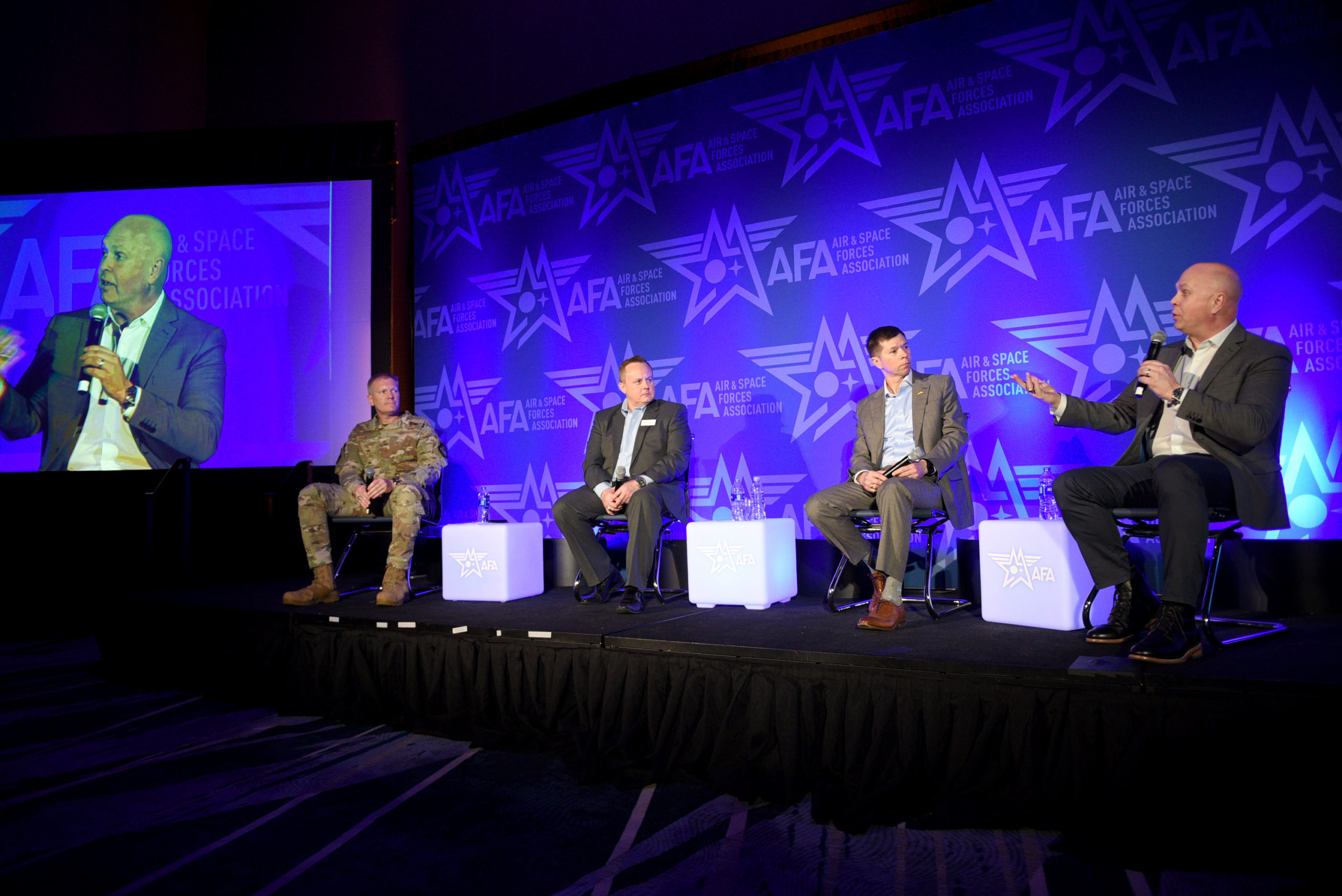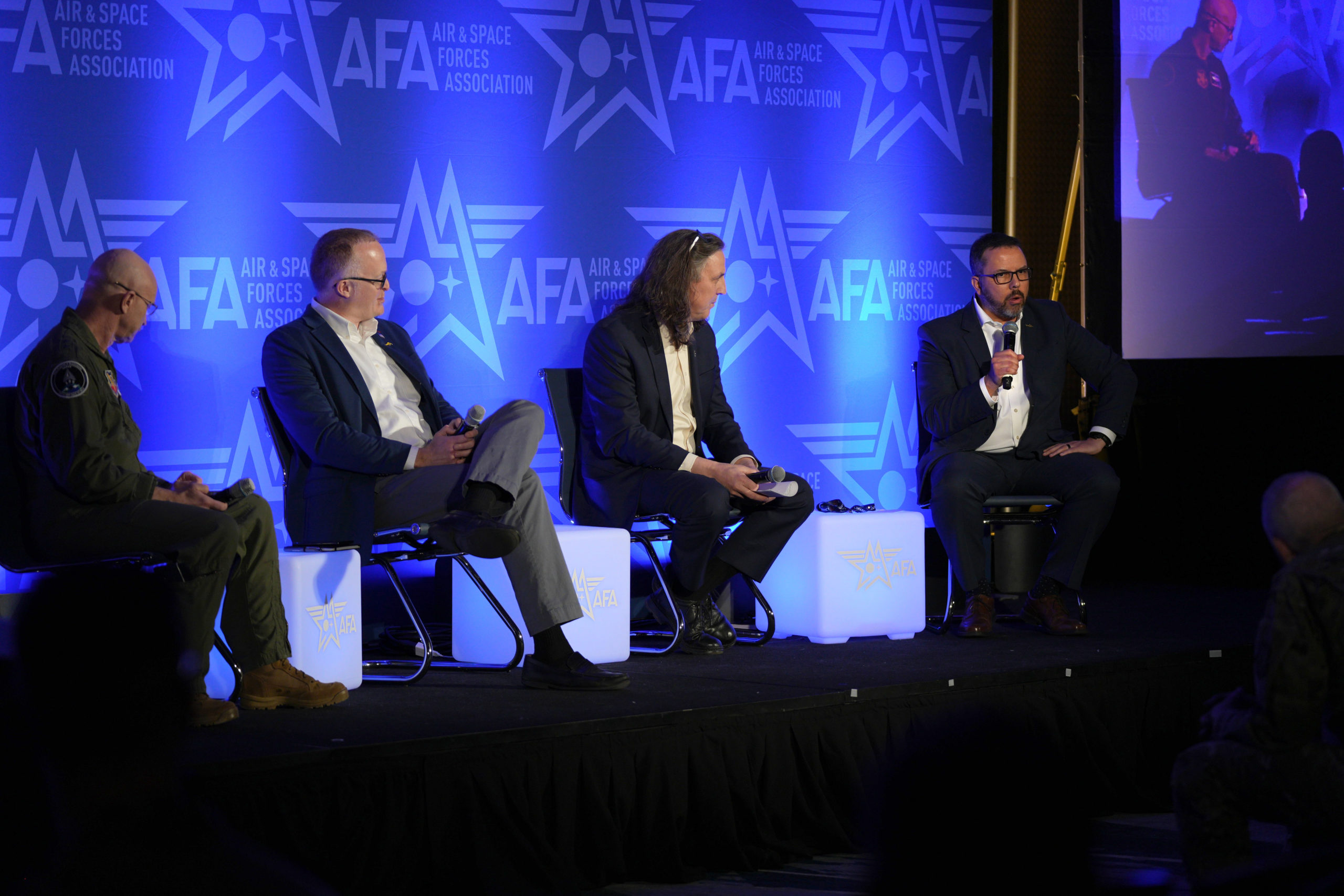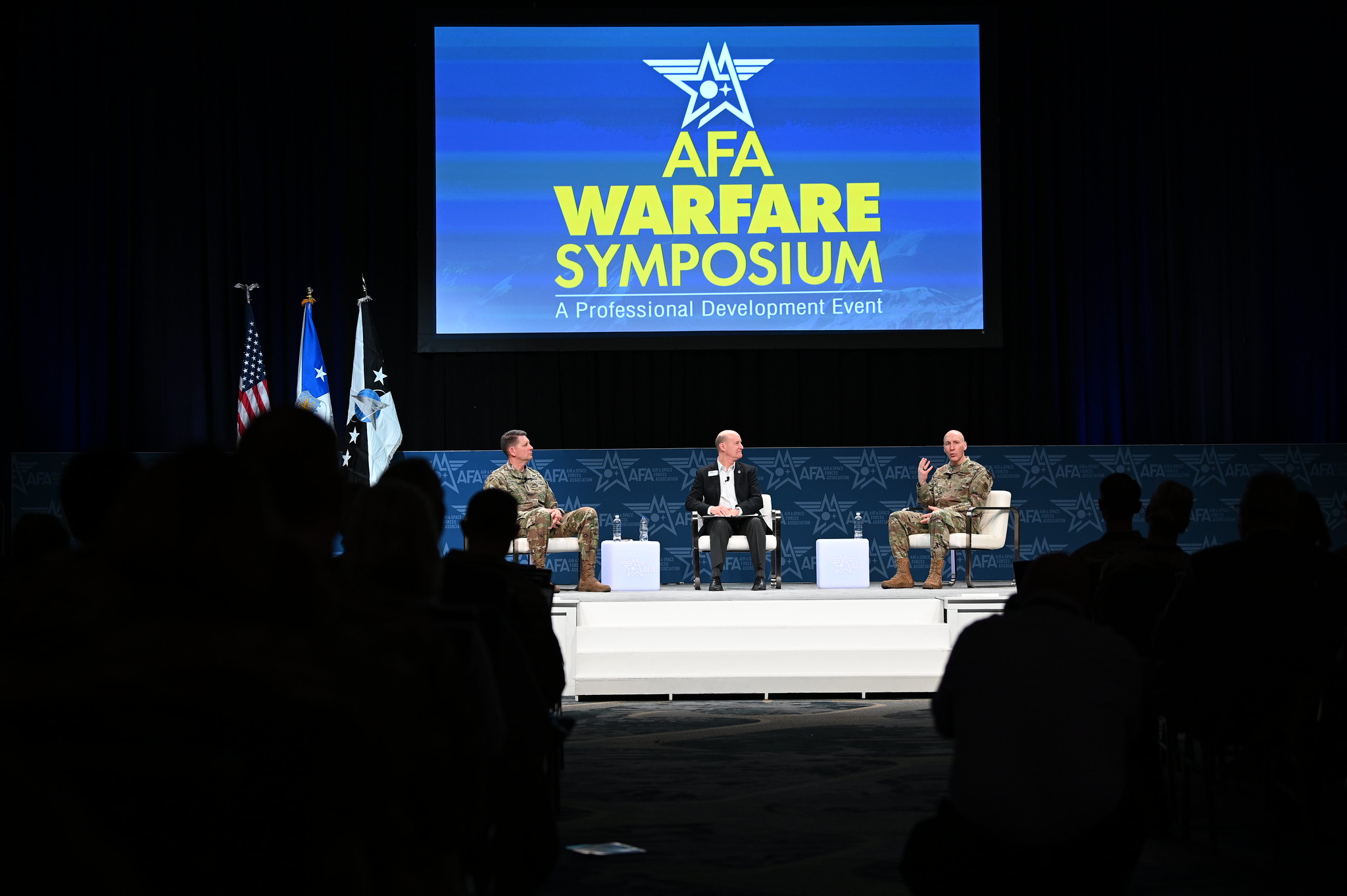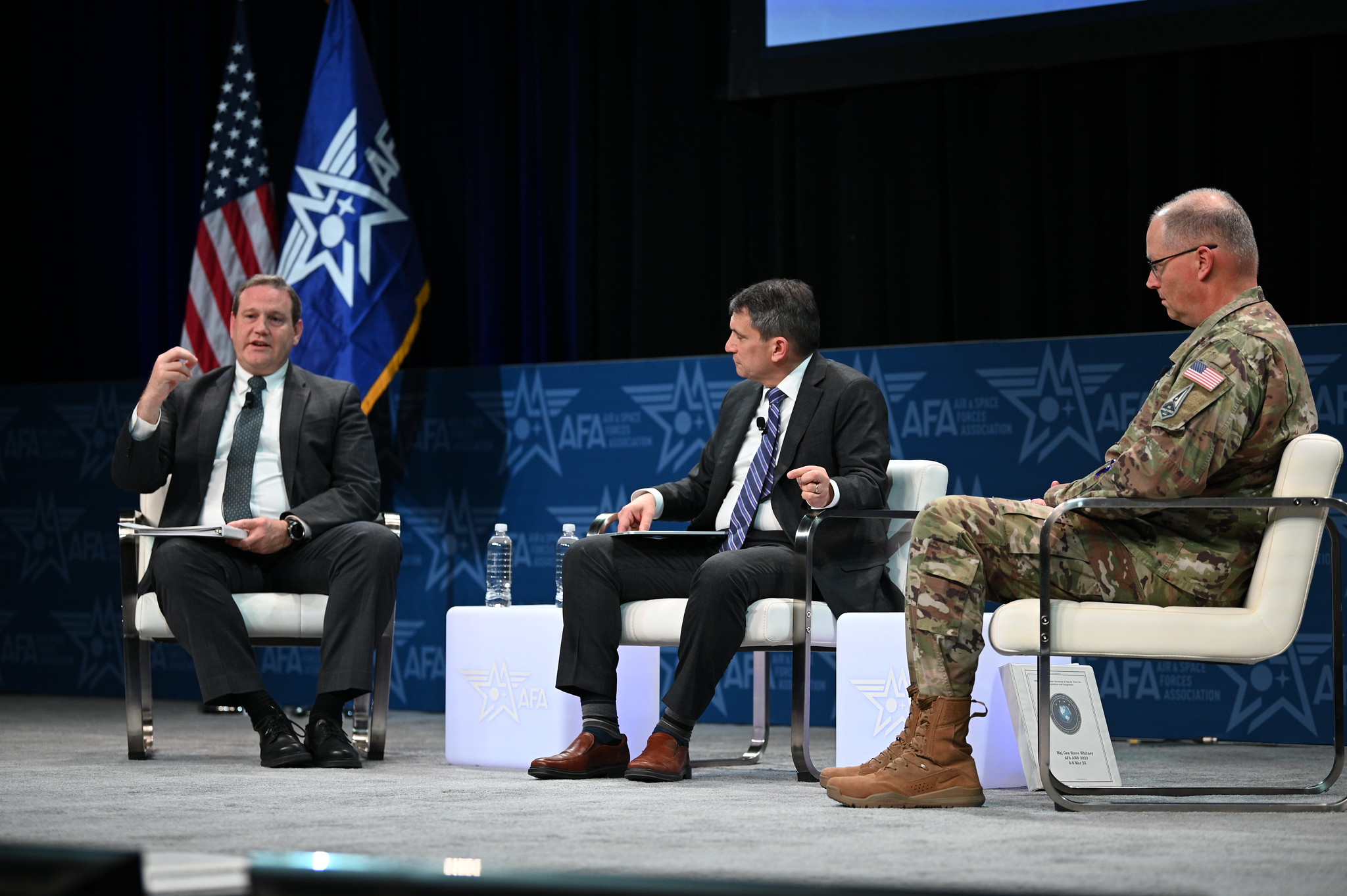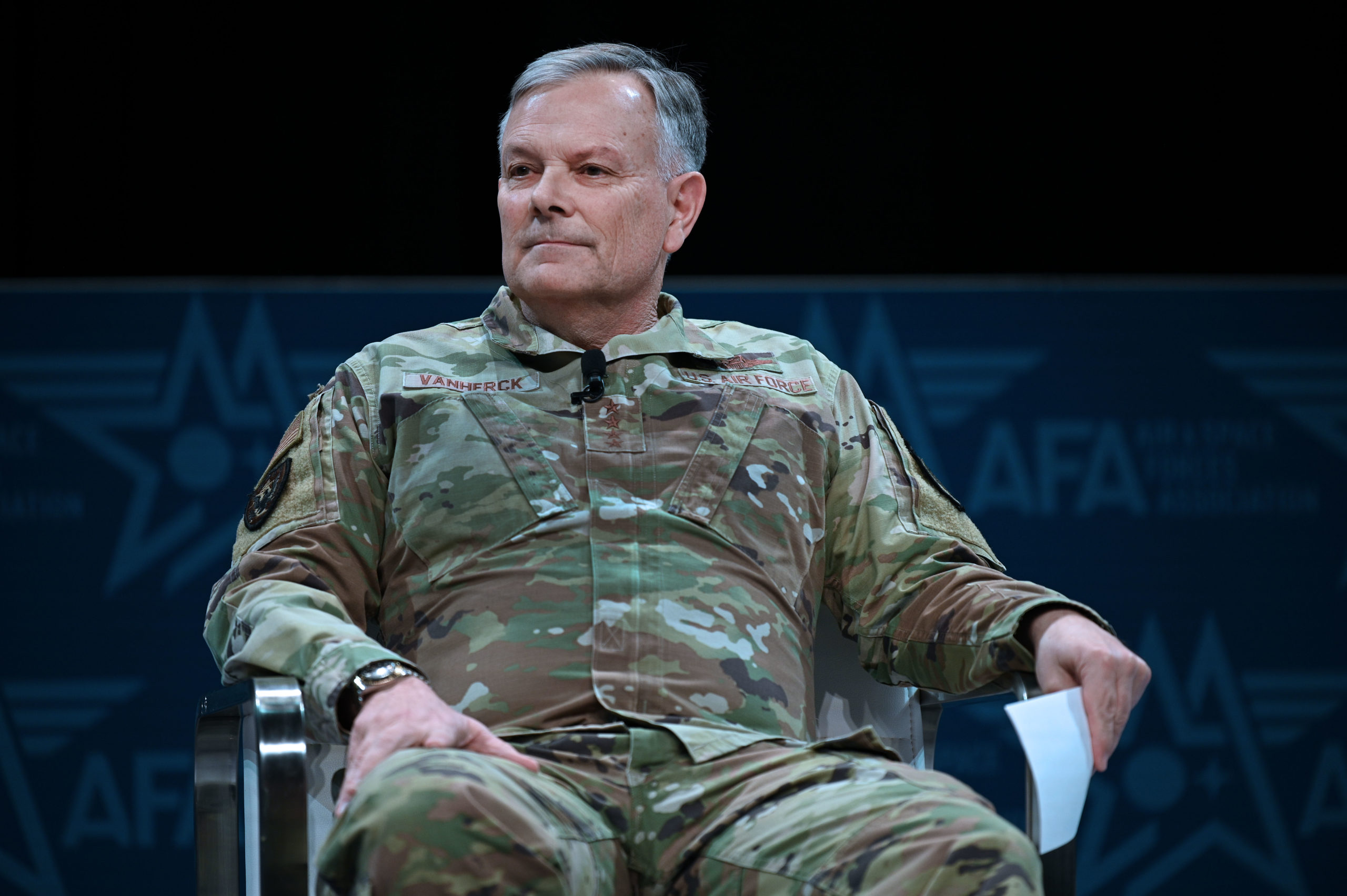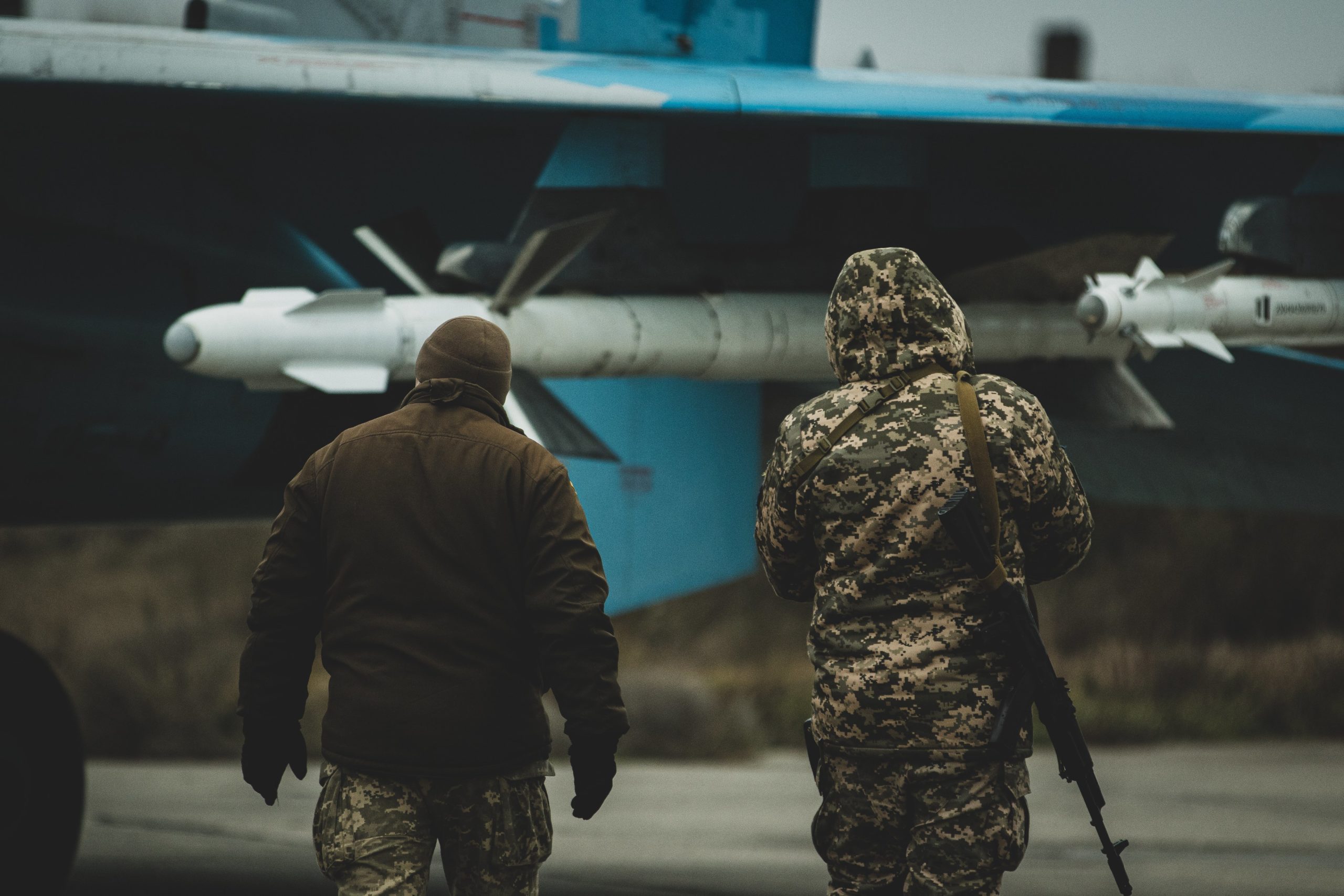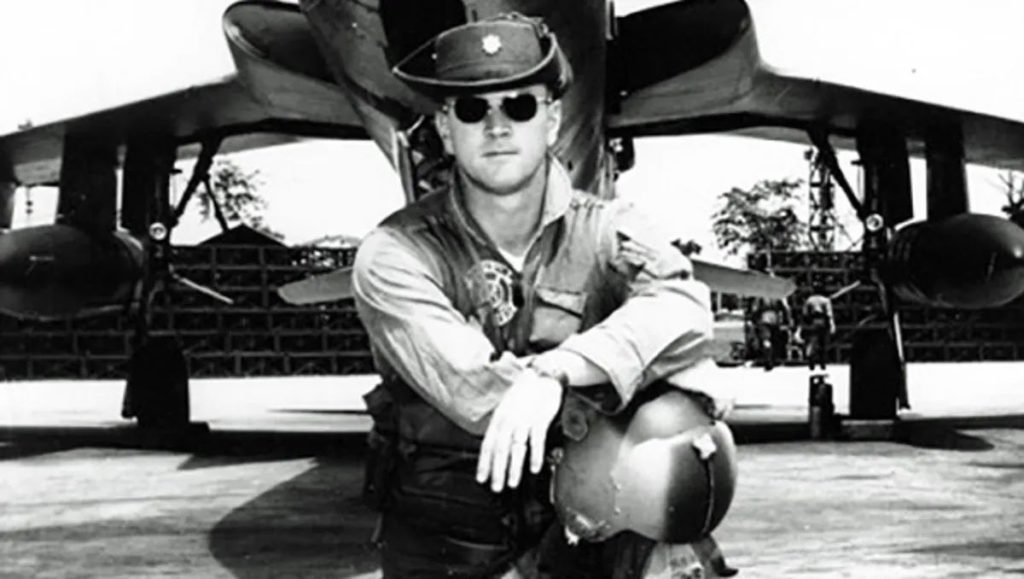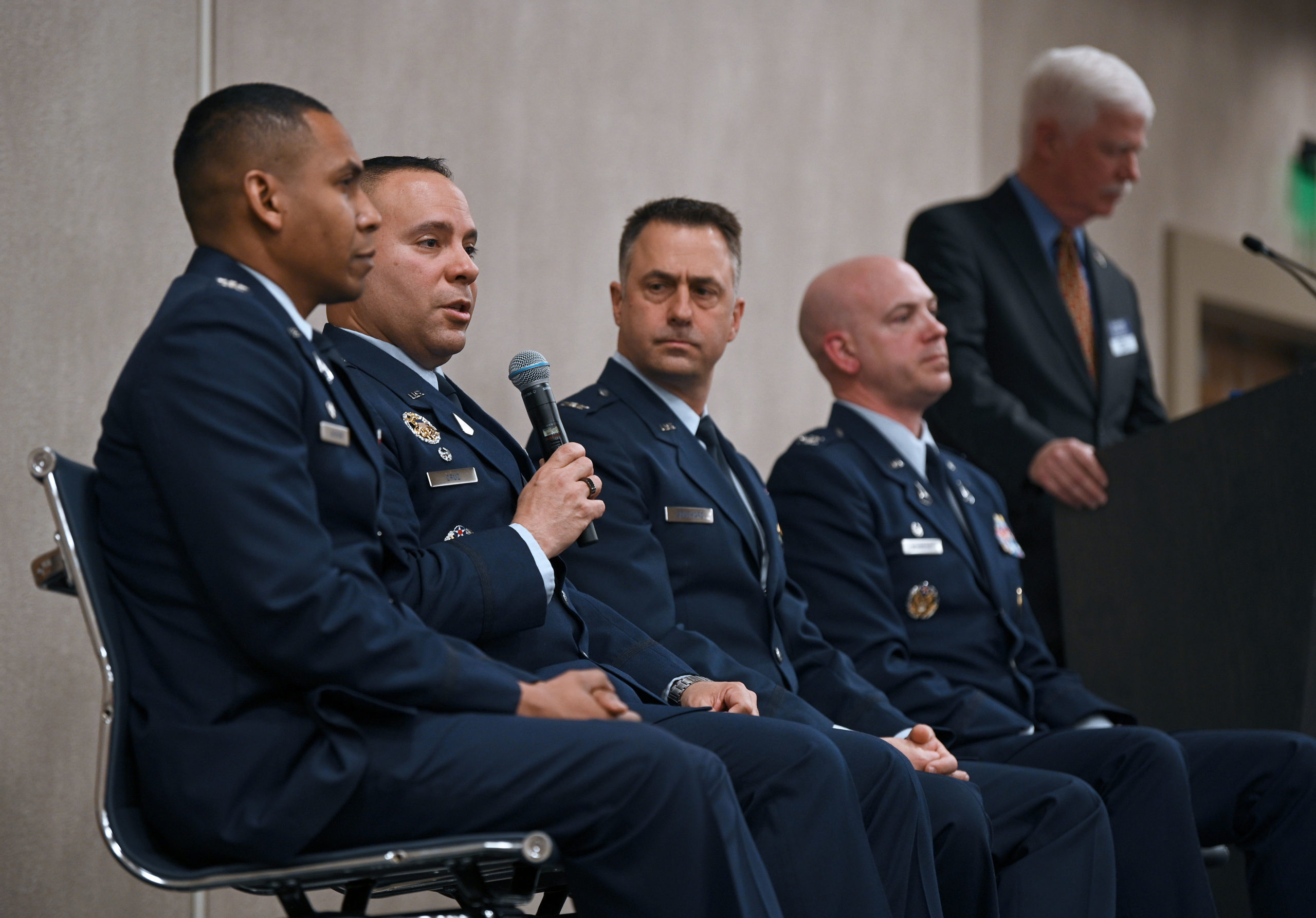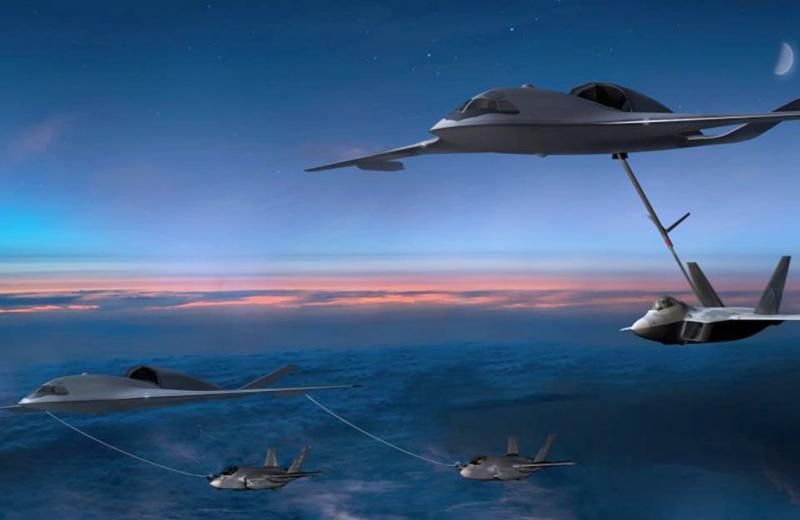To help the Air Force disperse and harden its forces to make targeting harder for adversaries, industry is considering things like better connectivity and more, panelists said March 7, 2023, at the AFA Warfare Symposium. The panel on ‘Defining Optimized Resilient Basing’ included Ryan Bunge, Vice President & General Manager Resilient Networking and Autonomy Solutions, Collins Aerospace; Thom Kenney, Technical Director, OCTO, Google; nad Brad Reeves, Director for C4I Solutions, Elbit America. Watch the video or read the transcript below.
Brig. Gen. Paul R. Birch, PhD.:
Hey, good afternoon teammates. My name is Paul Birch. I’m the Wing Commander at the 36th Wing Anderson Air Force Base on Guam, and …
Audience:
[Cheering]
Brig. Gen. Paul R. Birch, PhD.:
I did bring a cheering section. Thanks guys. This is the panel on optimizing resilient basing, and what I’m going to do is I’m going to introduce our illustrious panel here and then we’ll open with a few thoughts on what we’ve seen on that topic in Guam and why I’m so encouraged. But I just want to start off with a note of gratitude, how thankful I am to be here, how thankful that you all have joined us when we’re up against the Global Strike Command Keynote and a panel on the future of pilot training, which I know are very interesting topics.
So over here to my left, Ryan Bunge from Collins Aerospace, Brad Reeves from Elbit America, and Thom Kenney from Google OCTO. And I’ll just let these gentlemen introduce themselves a little bit more, say what their role in the company is and then say how JADC2 or ABMS is relevant to the topic of resilient basing. So Ryan, we’ll give you the floor first.
Ryan Bunge:
Yeah. Hey, thank you sir, and thanks for the opportunity to be here. I understand we’re up against a couple panels. We’re also up against beer down in the exhibit hall.
Brig. Gen. Paul R. Birch, PhD.:
That’s right.
Ryan Bunge:
So yeah, I’m Ryan Bunge. I’m The Vice President and General Manager of a business at Collins Aerospace that we call Resilient Networking and Autonomy. So really the strategic focus of my business has a lot to do with JADC2 ABMS.
But as I think about the context of this panel, if I think about resilient basing, I think the logistical problems you face today, sir, even in peace time and operating from a main operating base with infrastructure are probably challenging enough. But if I think about that in the threat that we face or in a future conflict, we start moving to agile combat employment operations, I think that challenge is going to grow considerably. So if you think about doing that in a distributed manner, you think about doing that maybe at more austere locations where you don’t have some of that infrastructure that you typically count on and you think about doing that in a CDOL environment in a contested environment or even a denied environment. I think it starts to become a pretty challenging.
And I think that from our vantage point of the world in the connectivity business, I think beyond just the challenges of marshaling the people, the resources, the wartime material, I think we’re seeing a growing importance of the ability to marshal the data, and that’s largely where our focus is. If you think about what might be the first knights of a conflict like that, if anyone was here to listen to the last panel, they touched on some of this, but that ability to get the ATO, that ability to maybe pop up on the network, get that C2 update, get that intel update, or in those first nights you may encounter things or sense things that you haven’t before, it’s not in your library.
You got to be able to get up on the net, get that critical information back into a cloud, back CONUS, get it processed, get your MDFs updated, get back out there and into the fight. So those things become pretty challenging in that CDOL environment. So the way that we’re looking at how we help that problem set is really the resiliency and redundancy of connectivity methods to get after that. And that’s part of your pace plan. Again, when you’re at that main operating base, you’ve likely got your fiber infrastructure, you’ve got your nipper, your sipper, all the ways that you enjoy today. You’ve probably got 5G capabilities coming online that help solve some of that problem. But again, when you move to some of those other contested area, you start moving down that pace plan a little bit to some of those alternate methods of doing that.
So certainly a lot of interest in commercial satcom now. As that maybe becomes less available, you move down or degrade to a military satcom maybe onto a tactical network or tactical mesh network, maybe even all the way down to HF. HF is maybe a capability we don’t talk a whole heck of a lot about, but there’s a lot of advancements going on in HF right now with wider bandwidths and digital mesh networking. I think it provides a really great opportunity for that kind of final step of your pace plan. It’s pretty easy to move, it’s easy to set up and it’s pretty darn hard to contest.
So we’re looking at things like that. And then I think maybe three other things I would point to as we think about or you contemplate building out that pace plan or setting up those capabilities to ensure that connectivity. I think we got to think about the joint and mission partner environment as we build that out. So as you think about maybe falling in on other preexisting locations or cooperative security kind of things, we need that ability to drive the interoperability with our partners that brings in things like cross domain solutions, different enclaves of security that we need to be able to operate and move that data through to be successful with our partners.
I think the second thing that we need to think about as we build that out also is assured P&T. None of these networks happen without time. And in a GPS contested environment, you need that AP&T ability to stand up those networks, provide that good known source of time. And then maybe that third aspect that I would point to is just the people side. So again, as we build out this pace plan, the redundant resilient networks, the ability to automate that, make that intuitive easy to use, bringing in AIML, some of the things that’ll help do that I think will be tremendously valuable. And then the ability to train for those scenarios. So as you think about training for that fight untethered way in that second or third island chain, doing it out for real, I think are important areas for us to focus on going forward.
Brig. Gen. Paul R. Birch, PhD.:
Great. Thanks Ryan. Brad Reeves.
Brad Reeves:
Yeah, thank you, sir. So I’m at Elbit America. I lead the C4ISR business segment there. And I’ll start with a spoiler alert. All right. And that is that you have a problem, a dilemma when it comes to resilient basing and projecting air power in the INDOPACOM Theater. You have to survive against a formidable missile threat. And one of the ways we’re doing that is by dispersing bases throughout that theater. And so enter part one of the dilemma, which I want you to not only survive but thrive, but in the dilemma, you have to have the numbers to do that and you just don’t have those numbers.
So a fun fact for you is during World War II, the US had 93 air bases abroad that carried us through the Cold War. Today we have 33. So this is a problem, right? And it means that the fixed sites, while absolutely important like Guam in critical are not going to be enough. We’re going to have to rely on expeditionary bases to do this. And so we’re not the only ones that have figured this out. The Marine Corps following your lead, they’re completely redesigning themselves and they have a concept of focus that they call expeditionary advanced base operations or EABO. It’s quite complimentary to our agile combat employment ACE concept inside of the Air Force.
But now inter dilemma part two, and that is that in order for these expeditionary bases, these austere locations to be effective, they have to have command and control and they have to have protection. So I’m full of bad news so far. I’m hopeful to give you some hope here right now to say in industry we’re trying to get after these problems. In America, what we’re doing to help you solve parts of these dilemmas is we have two main focus areas that we’re looking at.
The first is expeditionary survivable command and control, C2. The second is autonomous force protection solutions. And so these are related to the ACE concept. As a matter of fact, they tie into three of the five core elements: command and control, movement and maneuver, and protection. These are inside the ACE concept.
And so here’s what we’re doing to get after those. On the C2 side, what we’re bringing to the fight there is expeditionary survivable command and control. What does that look like? Think a mobile C2 platform that allows you to conduct C2 at the tactical level. So what is this? It could be a BDOC for base defense. It could be a NPC for mission planning for aircrew in between sort generations. It could be an AOC light type of function which allows you to operate and generate mission type orders when you get disconnected from the greater KOC. And it could be a WOC, a wing op center. So if you’re at the wing level to connect into the greater JADC2 network. Using things like resilient networks that my friend Ryan is talking about today, using machine learning and data management that my friend Thom is talking about today.
So this is what we have brought on the C2 side. And then on the protection side, in order for these expeditionary bases to be effective, we’re offering autonomous force protection solutions. And so with these, think a fully autonomous team of unmanned platforms that are able to conduct observation and sensing around the local area for that commander. And so this is not just the perimeter security and counter UAS though it certainly includes that it goes beyond the base, it goes through the island, it goes beyond the island even into the lateral maritime region. So now you’re getting into multi-domain air, land and sea awareness. And so this is the knowledge that the commander has to have in order to launch and recover air power in an effective and safe manner.
And for those that are old enough to remember Saturday morning cartoon commercials, we learned here that knowing is half the battle. So this is what we’re talking about with the protection. So this C2 and protection are things that we in industry owe you and things we’re working on at Elbit America to help you be more effective to not only survive, but to also thrive in this type of environment. And I’ll finish by just offering that first an applause to you to for being here because when the military-industrial complex, when we come together, history has shown that when we partner, we’re able to be a potent force and we’re able to deliver use systems and solutions that enable you to do what you do best, which is to arise, to go forth and to conquer.
Brig. Gen. Paul R. Birch, PhD.:
Thanks a lot Brad. Thom Kenney.
Thom Kenney:
Thank you General. I appreciate the opportunity to be here today with my colleagues. I’m from Google and I’m part of a group called the Office of the CTO, and that’s what General Birch referred to as OCTO. We call ourselves OCTO. And the role of the office of the CTO is specifically to be the technical leaders inside of Google Cloud that connect with our largest customers and solve some of our most challenging problems. And many of those problems are years away from being realized.
One of the exciting things about being in OCTO is the opportunity to look very, very broadly across a number of different industries and across a number of different agencies. As we stood up Google Public Sector, one of the things that we were looking at doing was bringing all of the best practices from the commercial sector that could apply to US government agencies, and particularly here now the Department of Defense and accelerate where we need to go now.
Now as we’re talking about JADC2 and some of the connections with ABMS, before I came to Google, I was the Chief Data Officer and Head of AI for SOCOM. And I can tell you the connectivity in data sharing problem is so real, especially when we think about strategic competition. Now, Google as an entity has grown up over the last 25 years and some have characterized us as a toddler in a suit, meaning we’re still very young relative to some other companies, but we’ve got some of the prowess to bring some of the expertise to the industry.
One of those things that I think is interesting about where we’re going is looking at data management at a planet scale. Now data management is one of those things that we lament about, we moan about. It’s one of the hardest things to do when you talk about working inside of JADC2 with the DOD. And part of that is contractually based. Part of that is we have a lot of legacy systems and part of it is we’re just not really sure exactly where we need to go. JADC2 is going through a new evolution Now it is no longer with the Joint Staff J6, but it’s now in the Chief Digital and AI Office trying to accelerate our path.
So as we look at it from Google perspective and we look at that planet scale data management, we recognize a couple of things that are related to resilient basing. The first is you don’t need all the data that exists all the time. So as we think about some of the ways that our adversaries have looked at pushing data, they’re pushing every single piece of data they have to every location. This is going to be a challenge for them in strategic competition. If we look at data management from the perspective of what is the most important information and where does it need to get to first, we can start creating the ability to transit data across the globe at speeds we’ve never seen before. If we also look at data management at what is the most information that the commander needs and the most relevant information that the commander needs, we can reduce the cognitive overload that we seem to get with a lot of systems that we have today.
How many of us have deployed overseas and had to deal with two or three or five different systems at a time and there’s information on one system that doesn’t match another system? As a Civil Affairs Officer in the Army Reserve, I can tell you this happened all the time. One deployment has one system, another deployment has another system, and in a third deployment, you’ve got three systems that are all doing the same thing. This idea of data management and ensuring that data is getting to the right people at the right time is absolutely critical.
As we think about the forward motion of what we need to do for strategic competition as it relates to JADC2 and resilient basing, one of the things that we recognize is that the information needs to get closest to the last mile as it possibly can. Thinking about having massive CONUS data centers cannot be the answer for where we need to be with JADC2, but nor do we need to replicate the size and capacity of every data center that we have in CONUS for those that are OCONUS.
As we look at where we need to go from a data center perspective and what needs to happen with machine learning, we work very, very hard to help people understand that you don’t need the same computing power to actually train an algorithm. That’s very computationally intensive. But there are companies out there today, one of which that I got to meet a little while ago that can put a computer vision algorithm onto a device the size of a SIM card that can recognize every commercial aircraft that exists in the world today. Imagine that. Imagine in a resilient basing model where weight and time is so important to deploying force, minimizing the amount of weight that you transmit out to a resilient base and minimizing the amount of data you have to transmit to a resilient base allows you to accelerate your opportunity faster and it gets the people that you need there faster.
Now, as a secondary, we’ve already heard this from the other panelists up here today that there’s more to this than just what we’re going to provide. And one of the things that we’re really excited about with Google when we talk about JADC2, there’s also the sustainment and the comms aspect of this too. And think about the power of bringing the best of breed software cloud and hardware companies together to drive this forward. Thinking about API-centric designs, thinking about what is the last time of value for data, thinking about what data do I need to make a strategic decision at what echelon at what time? And we’ve had a tremendous opportunity going forward. JADC2 is not going to be easy. Integrating it with ABMS, integrating it with all the other systems that exist today. This is a very hard problem to crack, but it’s not insurmountable.
Look at the things that we did in World War II ramping up our capability. Now, the technology was not the same on silicon. It was steel technology we were building, but we were able to do it because we had a very concerted effort, we had great leadership and we’re able to deliver. We can do the same thing with resilient basing. We can get to a point that whatever element size you need that needs to get to a forward operating location has the connectivity back to a global network that gives you the right information at the right time, whether it’s from a piece of hardware, a piece of software, or from boots on the ground.
Brig. Gen. Paul R. Birch, PhD.:
Great opening. Salvo, gentlemen, I appreciate it. I told you at the outset I wanted to unpack my optimism for we’re growing by leaps and bounds in this space. And I’m going to do that in the context of a recently completed exercise called COPE North, which is something we’ve done for many years in PACAF and Endo Paycom, and it’s a tri-lateral exercise traditionally with the United States, Australia and Japan.
But we just came off the 2023 iteration of that, and I would argue that it was nothing like its predecessors in terms of the scope and complexity of the basing problem we faced and tackled very successfully. So the realm of our operations went all the way up from Ioto, which you may know is Iwo Jima in the north, then down through Saipan, Tinian, Rhoda, Guam, all the way down through the Federated States of Micronesia and down to Palau.
And in that part of the second island chain, we operated no fewer than 10 hubs and spokes. Two of them were on Guam proper out of Anderson Air Force base and Juan Pat the international airport. But then a combination of fighter mobility, air power went to all these different spokes and generated in a way that simulated genuine lethality, genuine mission generation, things that would be useful in an enhanced competitive environment or a more competitive environment.
And what I saw was really night and day from some of the things I’d even heard in the Pentagon in the previous year, I would hear things like, “Well, we don’t know what it takes to buy a unit of ACE” or “I don’t really know what operational imperative five means when it says more resilient basing.” Now we can completely debunk those notions and say, “We know exactly what we need to do. We know exactly what the elements of ACE are and we know exactly what a resilient base looks like.”
And there’s several facets of both of those gems and there’s lots of low hanging fruit in each one. So let me kind of go from small to big in this case and just say what we recognize. They’re the first one. The imperative from PACAF leadership is having landing services and taxi services where we can put aircraft so that we complicate the enemy’s targeting problem and then we generate air power from so that we can be lethal. And I think it’s important to put those two together. We talked a lot about the first part of that, complicating the targeting problem, which is great and which is necessary, but at the end of the day, we don’t want to just be a target. We want to be something that can go do something useful to deter, compete, or win.
The second part of it is having the preposition war reserve material, the fuel, the weapons, the age, the MHE, the things we’ll need to be effective at those locations. Having them in the right scalability in the right amount so that you’re not overdoing it, so you’re not letting it rot out in the tough climates in the tough environments that we face out there. But certainly having it there and being able to flow it at scale just in time when we need to fight with it.
Another part of it is protection, and that takes many forms. You have high-end systems that are coming from the Missile Defense Agency to protect some of the population centers and the central hubs. But then we’ll also use things like concealment, camouflage, deception. We’ll use some other passive means. We’ll use some directed energy, we’ll use a variety of things at our disposal in a way that’s appropriate for the hub or spoke we’re at to protect ourselves from the adversary. But again, it’s all with the idea of not remaining a target, but rather getting the air power off the ground and into a spot where it can be lethal and then tied together with JADC2 concepts so that it knows what to do and we know how to bring the conflict to a rapid end.
In COPE North, we saw a couple things and it kind of reverberated out. And the first place was every wing, every unit in PACAF is coming together to do this. Some other panels have covered this very well. This is not a strange and abnormal thing in PACAF anymore, and it’s the way of the world in the Air Force. Now, General Grynkewich next door just talked about how they’re doing a AFCENT wide ACE exercise where all the wings are picking up, shuffling around, operating out base clusters just in the same way we did in COPE North. And it’s certainly happening at scale and Europe too. So what we’re doing is we’re seeing the entire Air Force imbued with this mindset, with these capabilities and getting the sets and reps to be truly competent.
The next thing to focus on is the fact that the entire world is coming out to these resilient bases to see what we need. And that’s going to drive us into our next question. So I have an idea how I need to protect my base and how do I need to protect my base cluster and what do I need at the various hubs and spokes. But one of the challenges we’ve found is we need to communicate that rapidly to industry, to the decision makers in Washington, DC, the appropriators, the people who ultimately set our budget.
So I’ll start with this next question for the panelists. What do you need to hear from the units in the field, from the operational leaders and from strategic leaders in DC to be more effective at helping US design solutions for resilient basing ACE or JADC2? Thom, I’ll hand it over to you first for this one.
Thom Kenney:
That’s a great question, sir. Thinking about what do we need to know in order to solve that problem?
One of the things from our perspective when we think about the large scale planet, scale work has to do with where are the levels of communication that need to happen? Because some of that communication is going to happen at the IL5 level, some at IL6 and some higher. How do we break that down? And then maybe a secondary question is, what is information that may be in a higher domain classification that actually doesn’t need to be, but just happens to be there as it is already? Those are the types of questions that then we can start saying when you’re thinking about the comms, when you’re thinking about the sustainment, once the base is there to answer the question of what do we need to continue to operate?
Now the question becomes a lot easier to share with a larger industrial base. Now you can open up the door to what suppliers do we need to communicate with? Where are those suppliers located? Who are your preferred suppliers? What are the preferred needs? What is the stack rank of needs for comms and for equipment and tooling that you would need to go forward? And I’ll give you an example of why I think this is so important. As you think about that resilient base and getting set up, you’re going to learn a lot in the first 24 to 48 hours. And all of the modeling that we do ahead of time is going to change in the first 24 to 48 hours. So understanding some of those needs and the hierarchy of needs for resilient basing allows companies like ours when we’re developing machine learning models for prediction on where the threats may come from, where are the needs for a sustainment come from, where we may we see communication failures and the backup needs for those resilient failures.
We can now apply automation and intelligence that allows the war fighter to concentrate on the war fighting rather than on the paperwork or rather on chasing all the vendors that you need to chase in order to make this happen. So that hierarchy of needs I think is really, really important. And sharing that hierarchy of needs at what domain and what classification with the time that you need that information is absolutely essential to driving really great machine learning, really great neural networks that help the predictive nature of what we need to do for war fighting and strategic competition.
Brig. Gen. Paul R. Birch, PhD.:
That was a great answer. I’ll give everybody a chance to pile in here, but when you talk about pushing information, where we need it, when we need it in the right level, I have to think about what it looks like in the second island chain when we’re under attack and heavily reliant on comm networks that either come from Hawaii or come from Japan, and rarely do they have redundancies that flow from one to the other. So how do we solve the problem of data management pushing data when we’re cut off from our home port as it were? How do you start to tackle that problem? And Ryan, why don’t we start with you for that?
Ryan Bunge:
Yeah, it’s a great question. So I think it builds on what I talked about from having resilient redundant avenues to go do that. And I think one of the really important technologies here to get to that, how do you cover that last mile that Thom talked about, or maybe in this case it’s the last a hundred miles or more, a thousand as you look at it, is applying that similar kind of AIML concepts to how we sense the electromagnetic spectrum and being able to then utilize the criticality of which packets of data have to get through. To Thom’s point, what are the pieces of information that need to get there? That’s an area that we’re doing a lot of work in actually have done a lot of work with DARPA, looking at how we sense that and then how we route the criticality of packets by the most assured method to ensure that data that has to get there gets there when it needs to.
Brig. Gen. Paul R. Birch, PhD.:
Okay, great. All right. And then Brad, what do you need to hear more from the user or how do we tackle this problem of getting cut off?
Brad Reeves:
Yeah, sure. Thank you, sir. So first I would say quick public advertisement if I can. For industry, what we really need from you, we don’t even need direct requirements even. We just need to engage. So we just need to be in part of the conversation. That’s what we are thirsty for. A lot of us were in the Air Force, for example. You kind of knew everything. You had a super net on your desk or a JWICS, you go into industry and it’s the black hole right? Now you know nothing, and so having those conversations is key. So just for all my industry partners, if I can just put that public advertisement out.
But as far as what we need in that conversation, we need, we really need to understand the CONOPS and where the TTPs and the way you’re thinking about this and I’ll just give you a kind of an example. So you alluded earlier, sir, there’s what I’ll call the exquisite type of solutions. So these are the things that Anderson could potentially have. When I was in the Pentagon a while back, we were addressing this issue and we had a company that came to us and I don’t remember all the details, but they said, “Hey, you need hardened shelters for all your bases. So seven foot 5,000 PSI reinforced concrete, and this will be the solution for a passive base protection measure.”
And I mean, great idea. I think we’d all love to do that. And at Anderson, we can might be able to do that. Expeditionary bases and all of these spokes, it’s just not practical for us to do that. So that’s the exquisite side. So then the CONOP becomes, “Okay, what do we do for the exquisite solutions where we have all the lake sharks with laser beams and stuff like that to defend the base? And then what do we do at the expeditionary hub?” So what’s the CONOP look like? Is it just General Brown said, “Hey all, I need to be able to launch and recover air power is I need a ramp, I need a runway, I need a weapons trailer, a fuel bladder, and a pallet of MREs and I can go.”
And that type of concept is not far from the truth for what is the realm of the practical. We can offer solutions that will enable you to do that type of launch or recovery of air power at our steer locations, at these expeditionary hubs. And we remember back in the day, we used to train for this. We used to train for landing on highways in South Korea or in Europe and you just had some fuel there. You had a few local things you’d turn, squeeze, and off you went. So we used to do all of this. We’ve kind of forgotten a lot of it. So a lot of this is from the past. If I can say borrow this term from the past in the future, that’s kind of where we’re going back. But it’s really us being a part of that conversation.
As far as how do we now manage the data that question, the way at least we’re addressing that at Elbit America is, we view that in, I’ll call them echelons. So we have the higher level global type of cloud, if you will, the all-knowing Skynet type of data. And that’s all great, but we’re not going to be connected to that. At some point during the fight we’re going to get disconnected. So then you would have a regional version of that if you will. And then most importantly, you then have a tactical level, a tactical cloud.
And so as you decrease in these, what you lose as you get disconnected is you don’t have all of the current information, but you still have last known data and you have enough to continue to fight the fight. And then the final defense is edge computing. And so today’s environment, and one of the things we’re working on is edge compute and putting AI on there. And that allows the war fighter, it allows you to reduce cognitive workload. It allows you to reduce the number of operators. It allows you to continue to fight the fight. It’s a degraded manner. But that’s one of the strengths of the US quite frankly, is our ability to command and control into issue mission type orders in old school.
When we were disconnected from the greater C2 networks, you had a captain, mission commander with his package of aircraft or assets. In this case we’ve got cyber space, all sorts of great assets. You gave him those assets and he or she went out and they went and they conquered the world and they conducted a mission and they did that and they made decisions at their level. And so pushing empowerment down, that’s where the TTPs come. But if we’re in the conversation, then we can help an industry deliver those solutions.
Brig. Gen. Paul R. Birch, PhD.:
Great. Great answers. Thank you all. Okay, let’s land this plane with one last discussion of resources specifically those we’re short on. So the title of this panel might be a little bit misleading. We’re talking about optimizing and when I think about optimizing, I usually think about reaching an inflection point where your use of resources is at a minimum. But it turns out that to be resilient and to have options and to be able to go to many places and to be able to effectively generate air power from those many places isn’t really efficient. So the thing that we’re optimizing here is maybe that balance and tension between efficiency and efficacy.
And one of the things that I’ve seen personally is it takes more people to run this. And that can be at your command and control echelon where you need now an AEW, an air expeditionary wing staff on top of an air expeditionary task force staff, and then the various staffs that are going to do those functions that keep a force fed and in the fight. And then even at the tactical level, my contingency response capacity, do I have the people that can go out and do those base opening functions to get us out there in the first place so that we can generate and then we can sustain in things?
And so that makes us acutely aware of the shortages we have. And some other panels have covered what we talked about, how many bases we used to have around the world and we don’t have that anymore. Trey Coleman in his AOC panel talked about the relative decline in the number of aircraft we had. And of course commensurate with that is a decline in none of other people.
So since we’ve got a panelist who are experts in this area, the question then becomes artificial intelligence, machine learning, what can those emerging technologies do for us in terms of making it more efficient to operate with the people that we do have? And Ryan, we’ll start with you on that one.
Ryan Bunge:
Yeah, so I think efficiency is really the key. In the concept of ACE, we talk about multi-dimensional Airmen, folks that can fall in and fulfill a number of different roles because as you say, the recruiting challenges, the distribution, the scale at which you’re going to have to get after this problem is going to put a huge strain on the number of people. So I think where AIML can help tremendously there is if you automate a lot of the tasks, the data management, you present more decision aiding, you make it easier for one airman to maybe perform a couple different functions with the support of that automation, it allows you to get a little more bang for the buck with the folks that you do have there.
And then I think just potentially a shift in how you deploy your resources. So if you think about one of the biggest challenges, we kind of joked about the tyranny of distance, the thousand miles, it puts every piece of your logistics chain in contention. So we think about how you automate some of that from a physical flight automation or uncrewed assets to move things around, does that allow you to free up then some resources to apply it to other parts of the problem set?
Brig. Gen. Paul R. Birch, PhD.:
Excellent. Brad.
Brad Reeves:
Yeah, so I love this question. So I’ll try to contain myself and not dance too much on stage because I do geek out on some of this technology and there’s a lot out there and there’s a realm that I’ve actually seen operate with my own eyes and now I get it. And so I’m going to try to plant something in your head with plant a picture to help you understand this.
So one of the things we’re doing, like all the folks here, we’re a global company. And so all the folks on the stage here, global company. So we’re pulling some technology from some of our overseas counterparts in Israel that just so happened to be, I am going to say the world leaders in autonomous war fighting. I don’t know if that’s really true or not, but that’s how I would label them. They’re really good at this and they’re doing it today.
And so we’ve brought some of this technology over and so our engineers have been working with theirs and we’ve transferred some of this knowledge. And what we’re able to do now with AI and machine learning autonomous systems is we’re able to do the full OODA loop, if you will, all the way from the planning, execution, debrief, assessment all the way back around in the loop to close that out. And you can do it fully autonomous.
And so what does this look like? So we have systems today, that technology exists where you can have one airman and he can operate an entire unmanned team that can take care of, let’s just say we’re, since we’re talking force protection, you mentioned that earlier force protection for the base. And so now you have some small platforms, you have one airman and you have what used to be, we would have hundreds and hundreds of base defenders, for example. And so you can augment a lot of that because the system will reduce the cognitive workload or in my terms, makes it easier for somebody to do a larger amount of work without thinking too much and it also reduces the number of operators that you need to do that.
And so it’s really game changing. And again, there’s the exquisite side where we’re talking the CCCA stuff where you have unmanned wingmen and all this on the fighter side, all the way down to here on the expeditionary basin side. But it is critical that the footprint is small enough that it’s actually something that can be … it has to be an executable plan. And so that in the expeditionary basing the elephant in the room is the sustainment of the logistics side of this. That’s one of the other elements I didn’t mention in ACE on purpose because it’s a can of worms, right?
How do you actually sustain or setup these bases? Well, I don’t have a great solution for you today, but I’ll just tell you in industry, the way we’re attacking that is we’re trying to come up with light and small systems that you can easily get them there because Thom mentioned the chip, right? Where you have all this type of machine learning and computer vision on a small chip. This is what we have to do. We have to use that autonomous capability, the AI to augment the humans and it becomes a force multiplier for us.
Brig. Gen. Paul R. Birch, PhD.:
Wonderful. Thanks. Thom.
Thom Kenney:
So you mentioned the word optimization and in computer science, an optimization problem is a classic problem to try to figure out how to do things a little bit better. If you apply optimization across the board, that’s where you can get a lot of really great value from tools like neural networks, machine learning, data optimization across the board. And how that reacts or relates to what we’ve all set up here, especially what Ryan and Brad have said is about how do we create the resilience and resilience spacing? That comes through resilience supply chains. So think about applying a machine learning model that’s using a neural network that can determine ahead of a human when there’s going to be a supply chain disruption.
The last a hundred miles as we’ll use here today or maybe the last thousand miles, knowing where that disruption is going to happen can be lots of different factors. It could be weather, it could be threat, it could be just shortage of something that’s not available. Having automated systems that can identify where the breaks in the chain may be and being proactive or predictive about solving that break in the chain is huge. Exactly what we’re talking about with base defense, what we’re talking about with air command and control, also what we’re talking about with communications.
This is an area where leveraging commercial networks is a huge advantage for the DOD, and that’s because we’ve been leveraging machine learning capabilities, other artificially intelligent agents to figure out how to do that resilience in our networks already. You may be connected to Hawaii, but if we know what the most important information is, if you get into a degraded connectivity environment and you’re leveraging some more of the commercial environments, you may not need to worry about whether or not I’ve only got an exposed box on the edge. You may have a great connection that you can get through Korea or through Australia or through the Philippines, and have it automatically route the communication traffic with the right priorities based on the needs in the phase of the operation that you’re actually in.
And this is what the real promise is. I mean, we talked earlier about we’ve got plenty of data, we’ve got plenty of data to run Skynet today, that may not be the best solution. And when we think about one of the challenges that we’ve got with man in the middle that seems to come up a lot, the difference between machine learning with logistics and machine learning with war warheads on foreheads is that we can make more mistakes in machine learning and logistics right now and learn how to build very resilient models that we can apply across a number of disciplines to support the needs of the war fighters that are at the edge.
Brig. Gen. Paul R. Birch, PhD.:
Outstanding. It’s exciting stuff.
Well, folks, I appreciate that we have only scratched a few of the facets on a gem that has many of them and is very complicated. But I know myself and the rest of my panelists, we’re willing to stay here for follow-on conversation if we didn’t hit part of the topic that you would’ve liked us to. And we know that the benefit of these conferences is the one-on-one interaction and the networking that happens too. I’d like to thank our host. I’d like to thank AFA for giving us all the opportunity to have this dialogue today. I wish you a safe evening and we’ll see you back here tomorrow. Thanks, and a hand for our panelists.
